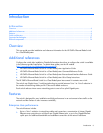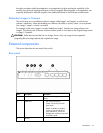
Introduction 10
Redundant paths to server bays
In a dual switch configuration, redundant Ethernet signals from each blade server are routed through the
enclosure backplane to separate switches within the enclosure. This configuration provides redundant
paths to each server bay.
Redundant Ethernet signals from each blade server are routed through the enclosure backplane to
separate switches within the enclosure. However, specific switch port to server mapping varies depending
on which type of server blade is installed.
On a heavily used system, using a single uplink port for 32 Ethernet signals causes a traffic bottleneck.
For optimum performance, HP recommends using at least one uplink port per switch.
Supported technologies
Layer 2 switching
The switch uses Gigabit Layer 2 switching technology. Layer 2 refers to the Data Link layer of the OSI
model, which is concerned with moving data packets across a network by enforcing CSMA/CD. This
layer performs:
• Ethernet packet framing
• MAC addressing
• Physical medium transmission error detection
• Medium allocation (collision avoidance)
• Contention resolution (collision handling)
Layer 2 switching technology allows the switch to look into data packets and redirect them based on the
destination MAC address. This reduces traffic congestion on the network because packets, instead of
being transmitted to all ports, are transmitted to the destination port only.
IEEE 802.1 Q-based VLAN
The switch provides support for a total of 255 IEEE 802.1Q VLANs for server grouping and isolation. A
VLAN is a network segment configured according to a logical scheme rather than a physical layout.
VLANs are used to combine any collection of LAN segments into an autonomous user group that appears
as a single LAN.
VLANs also logically segment the physical network into different broadcast domains so that packets are
forwarded only between ports within the VLAN. This technology enhances performance by conserving
bandwidth and improves security by limiting traffic to specific domains. For example, isolate the server
blade iLO ports from the rest of the NICs. The iLO ports on Switch 2 are assigned to their own VLAN and
go to a dedicated uplink or share an uplink using VLAN tagging.
IMPORTANT: The greater the number of VLANs, the greater the switch CPU utilization. For maximum
switch performance, HP recommends being judicious when configuring the number of VLANs.
NOTE: VLAN 4095 is reserved for future functionality.
Spanning Tree Protocol
The switch supports IEEE 802.1D STP, which allows the blocking of links that form loops between switches
in a network. When multiple links between switches are detected, a primary link is established.
Duplicated links are blocked from use and become standby links. If the primary link fails, the standby link
is activated.


















